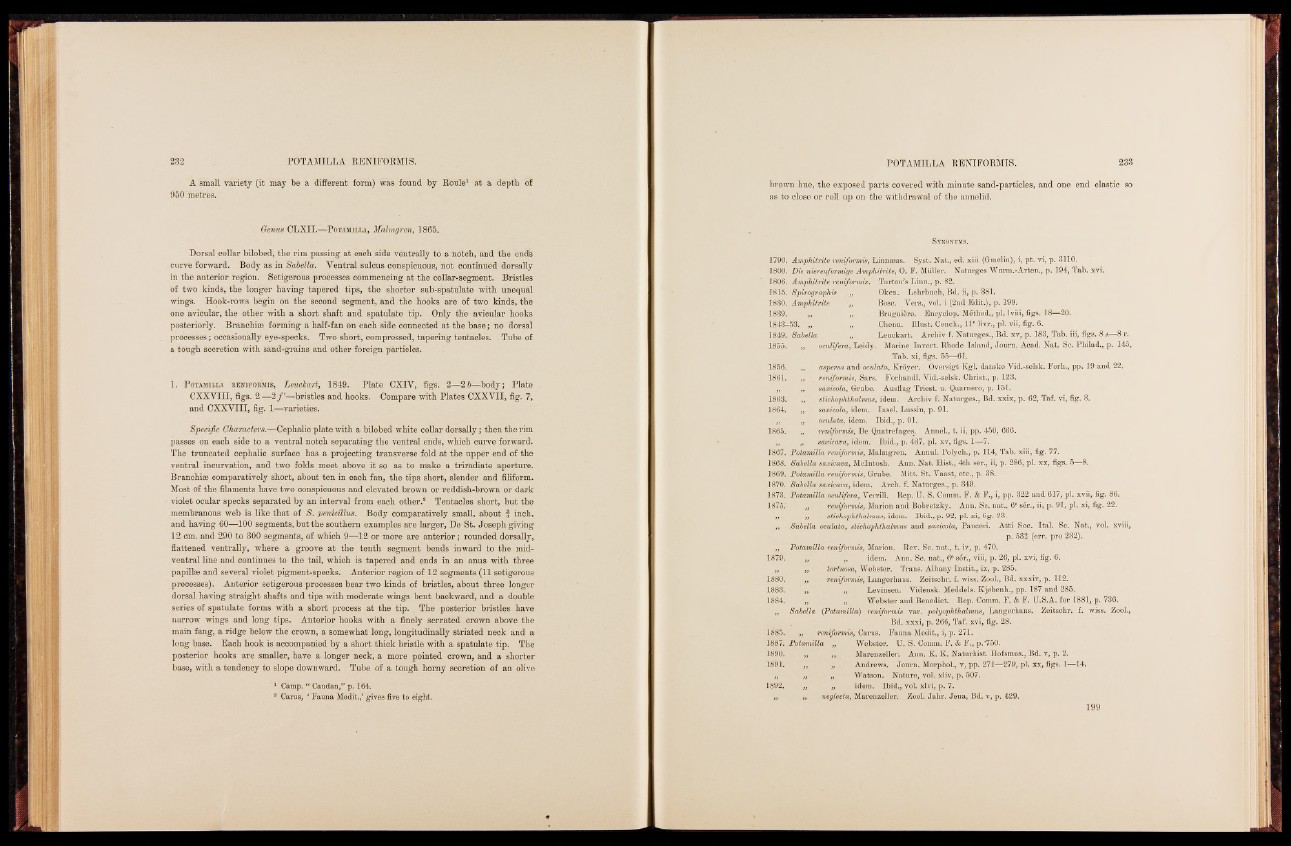
A small variety (it may be a different form) was found by Roule1 at a depth of
950 métrés.
Genus CLXII.—P otamilla, Malmgren, 1865.
Dorsal collar bilobed, the rim passing at each side ventrally to a notch, and the ends
curve forward. Body as in Sabella. Ventral sulcus conspicuous, not continued dorsally
in the anterior region. Setigerous processes commencing at the collar-segment. Bristles
of two kinds, the longer having tapered tips, the shorter sub-spatulate with unequal
wings. Hook-rows begin on the second segment, and the . hooks are of two kinds, the
one avicular, the other with a short shaft and spatulate tip. Only the avicular hooks
posteriorly. Branchiae forming a half-fan on each side connected at the base; no dorsal
processes; occasionally eye-specks. Two short, compressed, tapering tentacles. . Tube of
a tough secretion with sand-grains and other foreign particles.
1. P otamilla ren iformis, Leuclcart, 1849. Plate CXIV, figs. 2—2 b— body ; Plate
CXXVIII, figs. 2—2 ƒ'—bristles and hooks. Compare with Plates CXXVII, fig. 7,
. and CXXVIII, fig. 1—varieties.
Specific Characters.—Cephalic plate with a bilobed white collar dorsally; then the rim
passes on each side to a ventral notch separating the ventral ends, which curve forward.
The truncated cephalic surface has a projecting transverse fold at the upper end of the
ventral incurvation, and two folds meet above it so as to make a triradiate aperture.
Branchiae comparatively short, about ten in each fan, the tips short, slender and filiform.
Most of the filaments have two conspicuous and elevated brown or reddish-brown or dark
violet ocular specks separated by an interval from each other.8 Tentacles short, but the
membranous web is like that of S. penicillus. Body comparatively small, about f inch,
and having 60—100 segments, but the southern examples are larger, De St. Joseph giving
12 cm. and 290 to 300 segments, of which 9—12 or more are anterior; rounded dorsally,
flattened ventrally, where a groove at the tenth segment bends inward to the mid-
ventral line and continues to the tail, which is tapered and ends in an anus with three
papillae and several violet pigment-specks. Anterior region of 12 segments (11 setigerous
processes). Anterior setigerous processes bear two kinds of bristles, about three longer
dorsal having straight shafts and tips with moderate wings bent backward, and a double
series of spatulate forms with a short process at the tip. The posterior bristles have
narrow wings and long tips. Anterior hooks with a finely serrated crown above the
main fang, a ridge below the crown, a somewhat long, longitudinally striated neck and a
long base. Each hook is accompanied by a short thick bristle with a spatulate tip. The
posterior hooks are smaller, have a longer neck, a more pointed crown, and a shorter
base, with a tendency to slope downward. Tube of a tough horny secretion of an olive
1 Camp. “ Caudan,” p. 164.
2 Cams, | Fauna Medit./ gives five to eight.
brown hue, the exposed parts covered with minute sand-particles, and one end elastic so
as to close or roll up on the withdrawal of the annelid.
1790.
1800.
1806.
1815.
1830.
1839.
1843-
1849.
1855.
1856.
1861.;
1863.
1864.
1865.
1867.
1868.
1869.
1870.
1873.
1875;
1880.
-1883.
1884.
1885.
1887.
1890.
1891.
1892.
oculifera, Leidy.
Synonyms.
Amphitrite reniformis, Linnaeus. Syst. Nat., ed. xiii (Gmelin), i, pt. vi, p. 3110.
Die nierenformige Amphitrite, 0. F. Miiller. Naturges Wurm.-Arten., p. 194, Tab. xvi.
Amphitrite reniformis. Turton’s Linn., p. 82.
Spvrographis ,, Oken. Lehrbuch, Bd. ii, p. 381.
Amphitrite „ Bose. Vers., vol. i (2nd Edit.), p. 199.
,, „ Bruguière. Encyclop. Method., pi. Iviii, figs. 18—20.
53. „ „ Chenu. Illust. Conch., 11® livr., pi. vii, fig. 6.
Sabella „ Leuckart. Archiv f. Naturges., Bd. xv, p. 183, Tab. iii, figs. 8 a—8 f.
Marine Invert. Rhode Island, Joum. Acad. Nat. Sc. Philad., p. 145,
Tab. xi, figs. 55—61.
„ aspersa and oculata, Kröyer. Oversigt Kgl. danske Vid.-selsk. Forh., pp. 19 and 22.
„ reniformis, Sars. Forhandl. Vid.-selsk. Christ., p. 123.
„ saxicola, Grube. Ausflug Triest, u. Quarnero, p. 151.
„ stichophthalmus, idem. Archiv f. Naturges., Bd. xxix, p. 62, Taf. vi, fig. 3.
„ saxicola, idem. Insel. Lussin, p. 91.
„ oculata, idem. Ibid., p. 91.
„ reniformis, De Quatrefages. Annel., t. ii, pp. 450, 666.
saxicava, idem. Ibid., p. 437, pi. xv, figs. 1—7.
Potamilla reniformis, Malmgren. Annul. Polych., p. 114, Tab. xiii, fig. 77,
Sabella saxicava, McIntosh. Ann. Nat. Hist., 4th ser., ii, p. 286, pi. xx, figs, 5—8.
Potamilla reniformis, Grube. Mitt. St. Vaast, etc., p. 38.
Sabella saxicava, idem. Arch. f. Naturges., p. 349.
Potamilla oculifera, Verrill. Rep. U. S. Comm. F. & F., i, pp. 322 and 617, pi. xvii, fig. 86.
„ reniformis, Marion and Bobretzky. Ann. Sc. nat., 6e sér., ii, p. 91, pi. xi, fig. 22.
„ stichophthalmus, idem. Ibid., p. 92, pi. xi, fig. 23.
Sabella oculata, stichophthalmus and saxicola, Panceri. Atti Soc. Ital. Sc. Nat., vol, xviii,
p. 532 (err. pro 232).
Potamilla reniformis, Marion. Rev. Sc. nat., t. iv, p. 470.
„ „ idem. Ann. Sc. nat., 6e sér., viii, p. 26, pi. xvi, fig. 6.
„ tortuosa, Webster. Trans. Albany Instit., ix, p. 285.
„ reniformis, Langerhans. Zeitschr. f. wiss. Zool., Bd. xxxiv, p. 112.
,, „ Lëvinsen. Vidensk. Meddels. Kj^benh., pp. 187 and 285.
,, „ Webster and Benedict. Rep. Comm. F. & F. U.S.A. for 1881, p. 736.
Sabella (Potamilla) reniformis var. polyophthalmus, Langerhans. Zeitschr. f. wiss. Zool.,
Bd. xxxi, p. 266, Taf. xvi, fig. 28.
„ reniformis, Carus. Fauna Medit,, i, p. 271.
Potamilla „ Webster. TJ. S. Comm. F. & F., p.'750.
,, „• Marenzeller. Ann. K. K. Naturhist. Hofsmus., Bd. v, p. 2.
,, ,, Andi*ews. Journ. Morphol., v, pp. 271—279, pi. xx, figs. 1—14.
„ » Watson. Nature, vol. xliv, p. 507.
„ ,, idem. Ibid., vol. xlvi, p. 7.
„ neglecta, Marenzeller. Zool. Jahr. Jena, Bd. v, p. 429.